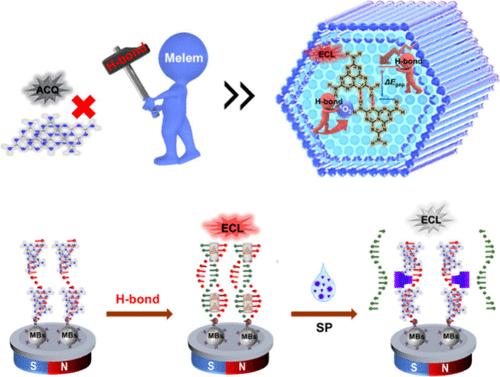当前位置:
X-MOL 学术
›
Anal. Chem.
›
论文详情
Our official English website, www.x-mol.net, welcomes your
feedback! (Note: you will need to create a separate account there.)
Hydrogen-Bond-Induced Melem Assemblies to Resist Aggregation-Caused Quenching for Ultrasensitive ECL Detection of COVID-19 Antigen
Analytical Chemistry ( IF 6.7 ) Pub Date : 2024-11-19 , DOI: 10.1021/acs.analchem.4c04016 Hao-Tian Zhu, Jing-Yi Bao, Jin-Wei Kang, Ai-Jun Wang, Pei-Xin Yuan, Jiu-Ju Feng
Analytical Chemistry ( IF 6.7 ) Pub Date : 2024-11-19 , DOI: 10.1021/acs.analchem.4c04016 Hao-Tian Zhu, Jing-Yi Bao, Jin-Wei Kang, Ai-Jun Wang, Pei-Xin Yuan, Jiu-Ju Feng

|
Nowadays, aggregation-caused quenching (ACQ) of organic molecules in aqueous media seriously restricts their analytical and biomedical applications. In this work, hydrogen bond (H-bond) was utilized to resist the ACQ effect of 2,5,8-triamino-1,3,4,6,7,9,9b-heptaazaphenalene (Melem) as an advanced electrochemiluminescence (ECL) luminophore, whose ECL process was carefully studied in an aqueous K2S2O8 system coupled with electron paramagnetic resonance (EPR) measurements. Notably, the H-bond-induced Melem assemblies (Melem-H) showed 16.6-fold enhancement in the ECL signals as compared to the Melem aggregates (Melem-A), combined by elaborating the enhanced mechanism. On such basis, the effective ECL signal transduction was in situ achieved through the specific recognition of the double-stranded DNA embedded in Melem-H assemblies (Me-dsDNA) with spike protein (SP) of coronavirus disease 2019 (COVID-19). For that, such an ECL biosensor showed a wider linear range (1.0–125.0 pg mL–1) with a lower limit of detection (LOD) down to 0.45 pg mL–1, which also displayed acceptable results in analysis of human nasal swab samples. Therefore, the work provides a distinctive insight on addressing the ACQ effect and broadening the application scope of the organic emitter and offers a simple platform for biomedical detection.
中文翻译:

氢键诱导的 melem 组装体抵抗聚集引起的淬灭,用于 COVID-19 抗原的超灵敏 ECL 检测
如今,有机分子在水性介质中的聚集诱导淬灭 (ACQ) 严重限制了其分析和生物医学应用。在这项工作中,氢键 (H-bond) 被用来抵抗 2,5,8-三氨基-1,3,4,6,7,9,9b-七氮杂苯 (Melem) 作为高级电化学发光 (ECL) 发光团的 ACQ 效应,其 ECL 过程在水性 K2S2O8 系统中与电子顺磁共振 (EPR) 测量耦合。值得注意的是,H键诱导的 Melem 组装体 (Melem-H) 显示,与 Melem 聚集体 (Melem-A) 相比,ECL 信号增强了 16.6 倍,通过阐述增强机制。在此基础上,通过特异性识别嵌入在 Melem-H 组装体 (Me-dsDNA) 中的双链 DNA 和 2019 冠状病毒病 (COVID-19) 的刺突蛋白 (SP) 来原位实现有效的 ECL 信号转导。为此,这种 ECL 生物传感器显示出更宽的线性范围 (1.0–125.0 pg mL–1),检测下限 (LOD) 低至 0.45 pg mL–1,这在人鼻拭子样本的分析中也显示出可接受的结果。因此,这项工作为解决 ACQ 效应和拓宽有机发射器的应用范围提供了独特的见解,并为生物医学检测提供了一个简单的平台。
更新日期:2024-11-19
中文翻译:

氢键诱导的 melem 组装体抵抗聚集引起的淬灭,用于 COVID-19 抗原的超灵敏 ECL 检测
如今,有机分子在水性介质中的聚集诱导淬灭 (ACQ) 严重限制了其分析和生物医学应用。在这项工作中,氢键 (H-bond) 被用来抵抗 2,5,8-三氨基-1,3,4,6,7,9,9b-七氮杂苯 (Melem) 作为高级电化学发光 (ECL) 发光团的 ACQ 效应,其 ECL 过程在水性 K2S2O8 系统中与电子顺磁共振 (EPR) 测量耦合。值得注意的是,H键诱导的 Melem 组装体 (Melem-H) 显示,与 Melem 聚集体 (Melem-A) 相比,ECL 信号增强了 16.6 倍,通过阐述增强机制。在此基础上,通过特异性识别嵌入在 Melem-H 组装体 (Me-dsDNA) 中的双链 DNA 和 2019 冠状病毒病 (COVID-19) 的刺突蛋白 (SP) 来原位实现有效的 ECL 信号转导。为此,这种 ECL 生物传感器显示出更宽的线性范围 (1.0–125.0 pg mL–1),检测下限 (LOD) 低至 0.45 pg mL–1,这在人鼻拭子样本的分析中也显示出可接受的结果。因此,这项工作为解决 ACQ 效应和拓宽有机发射器的应用范围提供了独特的见解,并为生物医学检测提供了一个简单的平台。


















































 京公网安备 11010802027423号
京公网安备 11010802027423号